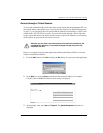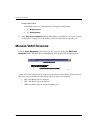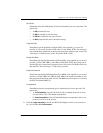
Appendix A: Accessing the Command-Line Interface
MM701G and MM702G User Manual 105
LAN IP Address
Enter 2 then type the IP address provided by your LAN administrator. Use the
following criteria to determine if or how the LAN IP address will be changed:
• Enter an IP address for the LAN (10Base-T) port provided by the LAN
administrator if you are not implementing a 10.0.0.0 subnet.
• Use the default IP address for the LAN port which is 10.0.0.1. If you choose to use
the default IP address, ensure that the devices on your LAN are on the same subnet
as this modem LAN port.
• If you want a DHCP server on your LAN to automatically provide the modem
LAN port IP address, select
Client for the DHCP configuration (configuration step
is on page 104).
LAN Subnet Mask
Enter 3 then type the LAN subnet mask provided by your LAN administrator. Use the
following criteria to determine if or how the LAN subnet mask will be changed:
• Enter the subnet mask for the LAN (10Base-T) port provided by the LAN
administrator.
• Use the default subnet mask for the LAN port which is 255.255.255.0. If you
choose to use the default subnet mask, ensure that it allows devices on your LAN
to access the modem LAN port.
• If you want a DHCP server on your LAN to automatically provide the subnet mask
in addition to the IP address, select
Client for the DHCP configuration
(configuration step is on page 104).
System Default Gateway
Enter 4 then type the IP address of the DHCP default gateway that is provided by the
LAN administrator for devices on the LAN. After you configure this IP address, the
modem provides this IP address as a default DHCP gateway to requesting DHCP
clients (such as PCs) on the LAN. If there are no gateways on the LAN, then the
modem LAN port IP address can be assigned as the gateway.
Ethernet Full Duplex
Enter 5 then select 2 for Enabled if you want to set the modem LAN port to full-duplex
transmission. Select
1 for Disabled (default) if you want to set the modem LAN port to
half-duplex.


















